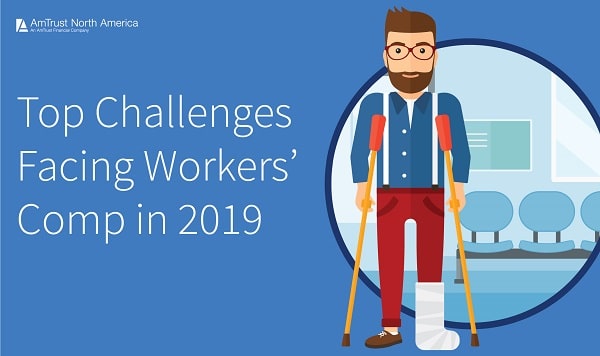10 Challenges Ahead for Workers’ Compensation

Let’s take a closer look at some of the issues that could affect workers’ compensation as we move forward into 2019.
1. Technological advances
Although the insurance industry is commonly thought of as moving at a slower pace than others, with recent
innovations in technology this is simply no longer the case.
Insurtech continues to build momentum with automation, connected devices and
artificial intelligence (AI) increasing the options business owners have while keeping costs low.
2. A focus on social determinants of health and the “psychology of pain”
An individual’s ability to recover and return to the workplace after a work-related injury often relies on social factors such as having a support system, safe housing and transportation. Workers’ compensation payors must focus on these issues by offering post-surgery care services possibly includingmeal delivery or in-home caregiving services. Additionally, the “
psychology of pain” refers to the fact that as patients focus on their pain, it tends to worsen. For this reason, the workers’ comp industry should focus on holistically treating pain with both medications, therapy and psychological support to help reduce disability.

3. Legalization of marijuana
Support for legalizing marijuana is at an all-time high in both the medical community and among consumers, and 33 states have now legalized medical marijuana. However,
employee rights regarding its use is still a hot debate. Maintaining a drug-free workplace and ensuring the safety of all employees will continue to be a major concern as more individuals may get prescribed medical marijuana in the coming year.
Around 53 million Americans are “gig” workers – professionals with an array of skills from home repair to accounting services who complete specific projects in exchange for compensation as independent contractors. As both large and small businesses utilize independent contractors, it’s important to understand the difference between these types of workers and full-time employees. The guidelines for
how to classify an independent contractor vary state by state, and there also may be different specifications statewide as far as workers’ comp coverage.
5. Changes in legislation
Elections may affect the workers’ compensation industry moving forward, especially considering states where the political party of the governor changed. As governors are responsible for appointing workers’ comp regulators and administrative law judges, this could influence the practice of workers’ compensation in those particular states.
6. The opioid epidemic
The
opioid epidemic affects employers in every industry, from farming to
nonprofits. From 1999 through 2017, almost 400,000 individuals died of an opioid overdose. Every state in the country introduced legislation related to prescription drugs back in 2018, with around 20 of them considering legislation addressing prescription drugs in workers’ comp. Two states, Hawaii and Arizona, passed such legislation.
7. The unemployment rate
The U.S. was at record low unemployment levels and wages continued to increase - until coronavirus hit. While the fact that the economy is doing so well is encouraging, higher payroll leads to higher workers’ compensation premiums. Furthermore, higher employment rates may mean less qualified or properly trained workers that increase the risk for accidents and injuries.
8. Workplace violence OSHA states that almost 2 million Americans are victims of
workplace violence every year, not including the cases that go undocumented. Day-to-day violence like physical assaults are a growing issue in industries like healthcare, retail and education. The problem is that many employees tend to feel like workplace violence comes with the job, and therefore don’t report incidents.
9. Mega claims Catastrophic injury claims can reach around $10 to $15 million, with industry data indicating that the amount of claims topping $5 million incurred continues to rise. Carriers are even seeing some claims as high as $40 million, which obviously can have a major impact on premium rates.
10. Leave of absence programs Finally, another workers’ comp issue involves
leave of absence programs, which more employers now offer as means to recruit and retain top talent. As these programs continue to grow in popularity, employers will need to plan how to accommodate employees, as well as how to coordinate leave with administration and workers’ comp.
Workers’ Compensation Coverage from AmTrust Financial
AmTrust has been your trusted partner for
workers’ comp coverage and small business risks for the past 20 years, and we are
stronger than ever. For more information about our small business insurance solutions please
contact us today.
This material is for informational purposes only and is not legal or business advice. Neither AmTrust Financial Services, Inc. nor any of its subsidiaries or affiliates represents or warrants that the information contained herein is appropriate or suitable for any specific business or legal purpose. Readers seeking resolution of specific questions should consult their business and/or legal advisors. Coverages may vary by location. Contact your local RSM for more information.